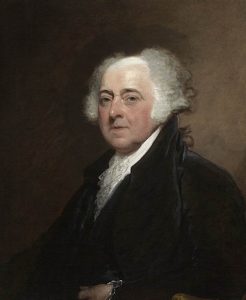Table of Contents
- I. Early Life
- II. Continental Congress
- III. Foreign Service
- IV. Political Philosophy
- V. Vice Presidency and Presidency
- VI. Retirement
- VII. Relationship with Thomas Jefferson
- VIII. Legacy and Death
- IX. Personal Life and Family
I. Early Life
- Born on October 30, 1735, in Braintree, Massachusetts, which is now Quincy.
- Family Background: The eldest of three sons of Deacon John Adams and Susanna Boylston. The Adams family was devoutly religious and were descendants of early Puritan settlers in New England.
- Education and Early Ambitions: Encouraged by his father to aspire for ministry, but his interest shifted over time. Graduated from Harvard College in 1755 with aspirations for the ministry. Instead, chose to teach for three years in Worcester, which provided him the chance to reflect upon his career path. Opted for law over ministry, becoming an apprentice to James Putnam. Moved back to Braintree in 1758 and began practicing law in Boston by 1761.
II. Continental Congress
- Rise as a Revolutionary Leader: By the 1770s, Adams emerged as a staunch advocate of the colonies’ independence from Britain. Played a significant role in the Continental Congress from 1774-1777. Along with cousin Samuel Adams, they were leaders of the radical faction advocating separation from England.
- Contributions and Writings: Authored the “Novanglus” essays in 1775, which countered the arguments for parliamentary authority made by loyalists. Nominated George Washington as the commander of the Continental Army, understanding the value of a Virginian leading the troops. Selected Jefferson to draft the Declaration of Independence and fiercely defended its adoption on July 2-4, 1776. Penned “Thoughts on Government”, which influenced the structure of many state constitutions.
III. Foreign Service
- Diplomatic Roles: Congress dispatched Adams to Paris in 1778 to negotiate a crucial alliance with France during the Revolution. Briefly returned home in 1779 to contribute to the Massachusetts Constitutional Convention. Key figure in the drafting of the Massachusetts constitution in 1780, which later served as a prototype for other state constitutions and the U.S. Constitution. Reappointed to Paris in 1784, alongside John Jay and Benjamin Franklin, to negotiate the Treaty of Paris, which formally ended the Revolutionary War.
IV. Political Philosophy
- Views on Revolution: Adams was wary of radical revolutionary ideologies and cautioned against unrealistic expectations. He believed that while class conflict was inevitable, it was necessary to ensure a balanced representation. Was critical of “ideology”, warning that pure ideals couldn’t always be translated to practical governance.
- Perspective on Governance: Believed in the inevitability of social elites but stressed that they needed oversight to prevent abuses.
V. Vice Presidency and Presidency
- First Vice President: Elected as the first vice president in 1789 under President George Washington. While in this role, Adams lacked significant power but held the responsibility of casting tie-breaking votes in the Senate. Supported most of Washington’s significant policies and took a Federalist stance on governance.
- Presidency: Secured the presidency in 1796 by defeating Thomas Jefferson in a tight race. Inherited many challenges from Washington, including tensions with France which escalated into the “quasi-war”. Though inclined to avoid an outright war, Adams strengthened the Navy. His tenure saw the controversial Alien and Sedition Acts of 1798, which were heavily criticized and deemed a political misstep. The election of 1800 was rife with political intrigue and tensions, and Adams lost to Jefferson in a bitterly contested race.
VI. Retirement
- Post-Presidential Years: After his presidency, Adams lived for another 25 years, witnessing the political ascent of his son, John Quincy Adams.
- Correspondence and Reflections: Maintained a significant correspondence with various contemporaries, notably Benjamin Rush and later, Thomas Jefferson, discussing a myriad of topics from personal anecdotes to the future of the young republic.
VII. Relationship with Thomas Jefferson
- Rivals to Friends: Initially close colleagues during the Revolution, Adams and Jefferson later found themselves as political rivals. After their presidencies, the two resumed their friendship and began a prolific correspondence, often reflecting on their roles in the nation’s founding.
- Legacy of Letters: Their letters, numbering over 150, remain a testament to the complexities of the era and the depth of their thoughts, touching on philosophy, governance, and personal reflections.
VIII. Legacy and Death
- Final Days: Adams often reminisced about the revolutionary era in his later years. On July 4, 1826, both John Adams and Thomas Jefferson passed away, marking the 50th anniversary of the Declaration of Independence. Adams’ final words are believed to have been “Thomas Jefferson survives”, unaware that Jefferson had died just hours earlier.
- Contributions: His legacy stands as a testament to the pivotal role he played in shaping the new republic. Adams’ work, from diplomatic services to his reflections on governance, played a critical role in establishing the United States as a nation.
IX. Personal Life and Family
- Marriage: Married Abigail Smith in 1764. Their enduring relationship, well-documented through letters, remains a beacon of mutual respect and deep affection, offering a window into the revolutionary era.
- Offspring: Together, they had six children, including John Quincy Adams, who would go on to become the 6th President of the United States. The family’s journey was not without tragedy, with some children passing away young, but their legacy in American politics is unparalleled.

